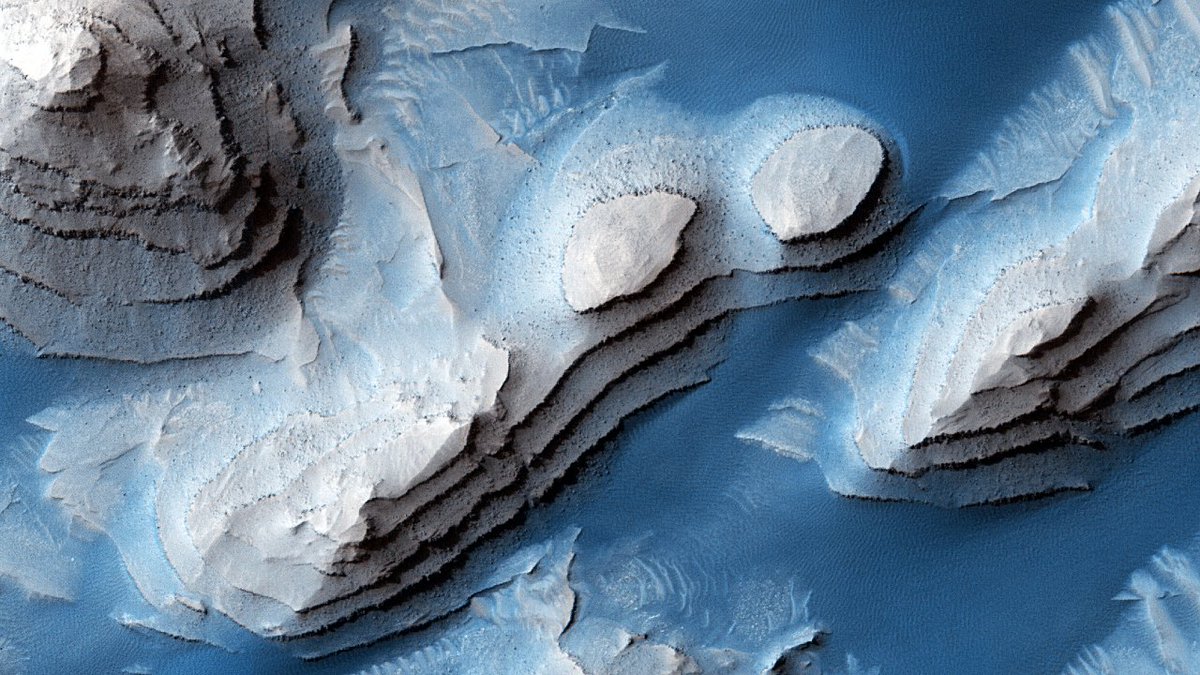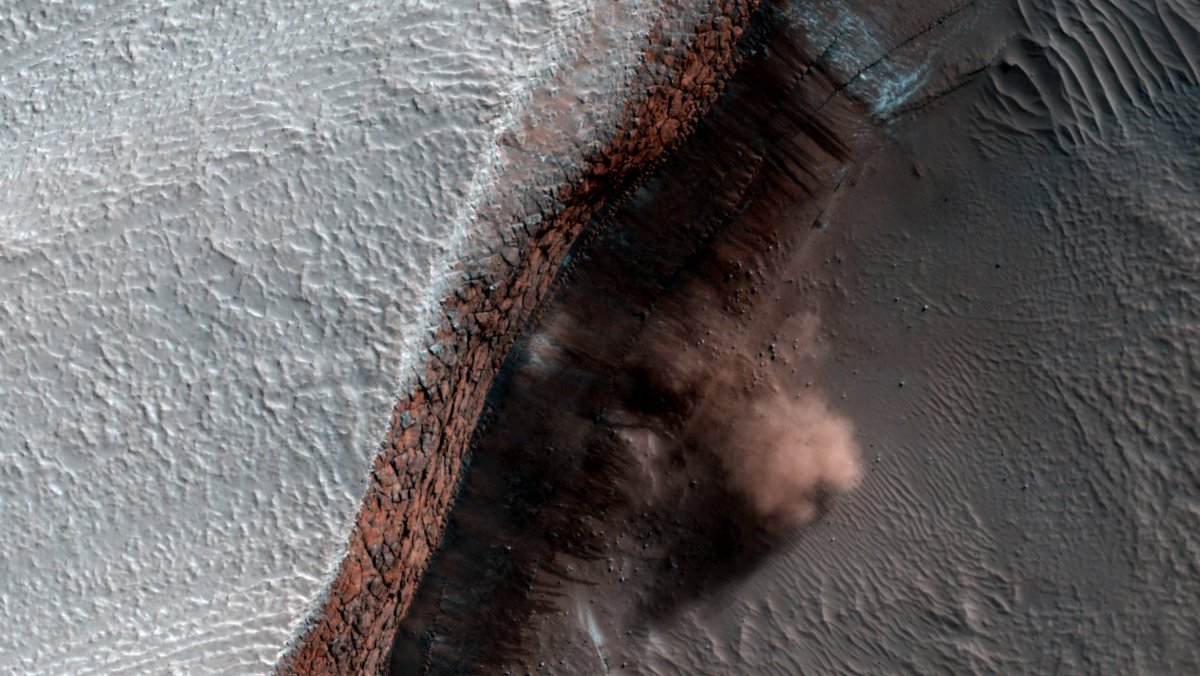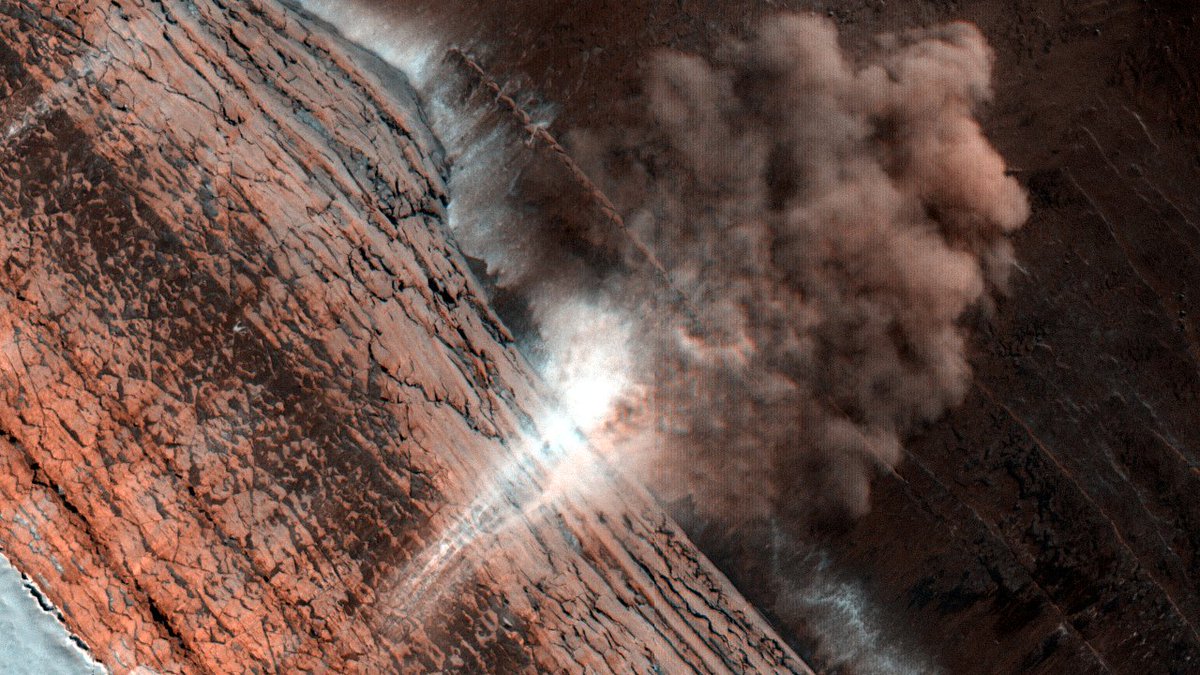I sometimes forget that we have a huge telescope in orbit of #Mars, returning some *amazing* high-res images of the Red Planet.
This is an enhanced-colour view from @HiRISE of sand dunes (basalt and gypsum grains) in the vast dune sea near the north pole—and it& #39;s just beautiful.
This is an enhanced-colour view from @HiRISE of sand dunes (basalt and gypsum grains) in the vast dune sea near the north pole—and it& #39;s just beautiful.
(Field of view in this scene is ~750 m across; the image shows an area centered at 84.7°N, 0.8°E, taken in 2008. For more: https://www.uahirise.org/PSP_009324_2650 )">https://www.uahirise.org/PSP_00932...
What& #39;s that? I should be making lectures?
Whatever. Here& #39;s another *gorgeous* @HiRISE view of #Mars—this time, an enhanced-colour view of layered units in the 64-km-diameter Danielson crater, carved and exposed by erosion. I mean, come on Mars https://abs.twimg.com/emoji/v2/... draggable="false" alt="😍" title="Smiling face with heart-shaped eyes" aria-label="Emoji: Smiling face with heart-shaped eyes">
https://abs.twimg.com/emoji/v2/... draggable="false" alt="😍" title="Smiling face with heart-shaped eyes" aria-label="Emoji: Smiling face with heart-shaped eyes">
Whatever. Here& #39;s another *gorgeous* @HiRISE view of #Mars—this time, an enhanced-colour view of layered units in the 64-km-diameter Danielson crater, carved and exposed by erosion. I mean, come on Mars
(Field of view is ~650 m across, centered at 8.3°N, 353°E. For more: https://hirise.lpl.arizona.edu/ESP_026349_1885 )
(I& #39;ve">https://hirise.lpl.arizona.edu/ESP_02634... a feeling I& #39;m gonne be posting more of these...)
(I& #39;ve">https://hirise.lpl.arizona.edu/ESP_02634... a feeling I& #39;m gonne be posting more of these...)
(This one& #39;s a crater with no name (as far as I can tell), about 1.4 km across, situated within a vast region called Meridiani Planum and about 116 km southeast of the Opportunity @MarsRovers *sniffle*)
(Read more: https://www.uahirise.org/ESP_039628_1765 )">https://www.uahirise.org/ESP_03962...
(Read more: https://www.uahirise.org/ESP_039628_1765 )">https://www.uahirise.org/ESP_03962...
Or, y& #39;know, those avalanches of frost and dust that @HiRISE has spotted, which show that #Mars is geologically active *today*?!
Near the north pole, sunlight warms up these frost–dust layers in the spring, driving material down these 100s-m-high cliffs. Active Mars!! https://abs.twimg.com/emoji/v2/... draggable="false" alt="❤️" title="Red heart" aria-label="Emoji: Red heart">
https://abs.twimg.com/emoji/v2/... draggable="false" alt="❤️" title="Red heart" aria-label="Emoji: Red heart">
Near the north pole, sunlight warms up these frost–dust layers in the spring, driving material down these 100s-m-high cliffs. Active Mars!!
(These images show an area a few hundred meters across, and were both taken in 2010. For more, see https://www.uahirise.org/ESP_016423_2640 ">https://www.uahirise.org/ESP_01642... and https://www.uahirise.org/ESP_016228_2650 !)">https://www.uahirise.org/ESP_01622...

 Read on Twitter
Read on Twitter
 " title="What& #39;s that? I should be making lectures?Whatever. Here& #39;s another *gorgeous* @HiRISE view of #Mars—this time, an enhanced-colour view of layered units in the 64-km-diameter Danielson crater, carved and exposed by erosion. I mean, come on Mars https://abs.twimg.com/emoji/v2/... draggable="false" alt="😍" title="Smiling face with heart-shaped eyes" aria-label="Emoji: Smiling face with heart-shaped eyes">" class="img-responsive" style="max-width:100%;"/>
" title="What& #39;s that? I should be making lectures?Whatever. Here& #39;s another *gorgeous* @HiRISE view of #Mars—this time, an enhanced-colour view of layered units in the 64-km-diameter Danielson crater, carved and exposed by erosion. I mean, come on Mars https://abs.twimg.com/emoji/v2/... draggable="false" alt="😍" title="Smiling face with heart-shaped eyes" aria-label="Emoji: Smiling face with heart-shaped eyes">" class="img-responsive" style="max-width:100%;"/>

 " title="Or, y& #39;know, those avalanches of frost and dust that @HiRISE has spotted, which show that #Mars is geologically active *today*?!Near the north pole, sunlight warms up these frost–dust layers in the spring, driving material down these 100s-m-high cliffs. Active Mars!! https://abs.twimg.com/emoji/v2/... draggable="false" alt="❤️" title="Red heart" aria-label="Emoji: Red heart">">
" title="Or, y& #39;know, those avalanches of frost and dust that @HiRISE has spotted, which show that #Mars is geologically active *today*?!Near the north pole, sunlight warms up these frost–dust layers in the spring, driving material down these 100s-m-high cliffs. Active Mars!! https://abs.twimg.com/emoji/v2/... draggable="false" alt="❤️" title="Red heart" aria-label="Emoji: Red heart">">
 " title="Or, y& #39;know, those avalanches of frost and dust that @HiRISE has spotted, which show that #Mars is geologically active *today*?!Near the north pole, sunlight warms up these frost–dust layers in the spring, driving material down these 100s-m-high cliffs. Active Mars!! https://abs.twimg.com/emoji/v2/... draggable="false" alt="❤️" title="Red heart" aria-label="Emoji: Red heart">">
" title="Or, y& #39;know, those avalanches of frost and dust that @HiRISE has spotted, which show that #Mars is geologically active *today*?!Near the north pole, sunlight warms up these frost–dust layers in the spring, driving material down these 100s-m-high cliffs. Active Mars!! https://abs.twimg.com/emoji/v2/... draggable="false" alt="❤️" title="Red heart" aria-label="Emoji: Red heart">">


